Lancia Thesis 2007 Owner handbook (in English)
Manufacturer: LANCIA, Model Year: 2007, Model line: Thesis, Model: Lancia Thesis 2007Pages: 386, PDF Size: 8.69 MB
Page 251 of 386

250
STARTING
THE ENGINE
IMPORTANTThe car is equipped
with electronic engine immobilising
system. If the engine fails to start,
see paragraph “Lancia CODE sys-
tem”.
We recommend that
during the initial period
you do not drive to full
car performance (e.g.: excessive
accelerations, long journeys at
top speed, sharp braking etc.).It is dangerous to let the
engine run in a garage or
other closed area. The
engine consumes oxygen and
gives off carbon oxide, a poiso-
nous gas.
The ignition device is fitted with a
safety device which obliges the dri-
ver to return the key to STOPposi-
tion before repeating the starting
procedure.
In the same way, when the engine
is running, this device prevents any
shift from MARto AVV.Never leave the ignition
key at MAR when the
engine is off to prevent
battery draining due to current
absorption.
DRIVING YOUR CAR
Page 252 of 386

251
HOW TO START PETROL
VERSIONS
IMPORTANTNever press the
accelerator before the engine has
started.
1) Ensure that the electric parking
brake is on (instrument panel warn-
ing light xon).
2) Ensure that electrical systems
and devices, especially high absorp-
tion ones (e.g. heated rear window),
are off.
3) On versions with manual gear-
box, set the gear lever to neutral and
press the clutch pedal fully down to
avoid the starter dragging the gears.4) On versions with electronic
automatic gearbox, ensure that the
selector is at Pand keep the brake
pedal pressed.
5) Turn the ignition key to AVV
and release it as soon as the engine
starts.
6) If the engine fails to start, return
the key to STOPand repeat the pro-
cedure.
IMPORTANTIf the engine does
not start at the first attempt, do not
keep turning the ignition key to
avoid damaging the catalyst.
Contact a Lancia Dealership.HOW TO START JTD VERSIONS
1) Ensure that the electric parking
brake is on (instrument panel warn-
ing light xon).
2) Put the gear lever to neutral.
3) Turn the ignition key to MAR.
4) Wait until the mwarning light
is off: the hotter the engine is, the
quicker this will happen.
When the engine is particularly hot
the warning light may come on so
quickly that it is impossible to notice
it.
5)Press the clutch pedal down to
the floor.
6) Turn the ignition key to AVV
immediately after the mwarning
light goes out. If you wait too long,
you will lose the benefit of the work
done by the glow plugs.
Page 253 of 386

252
IMPORTANTEnergy-absorbing
devices (climate control system,
heated rear window etc.) are auto-
matically disconnected at starting.
If the engine does not start at the
first attempt, return the ignition key
to STOPbefore trying to start the
engine again.
If starting is particularly diffi-
cult,(with the Lancia CODE system
working properly) do not keep try-
ing too many times.
Use an auxiliary battery only if the
battery has insufficient charge.
Never use a battery charger to start
the engine. ENGINE WARMING UP
– Begin to move forward slowly let-
ting the engine turn at medium revs.
Do not accelerate abruptly.
– Do not push the engine to its limit
for the first few kilometers. You are
recommended to wait until the
coolant temperature has reached 50
to 60 °C.STOPPING THE ENGINE
– Release the accelerator pedal and
wait until the engine is idling.
– Turn the ignition key to STOP
and turn the engine off. For versions
with electronic automatic gearbox,
put the selector to Pbefore turning
the engine off.
IMPORTANTAfter a taxing drive
you should allow the engine to
“catch its breath” before turning it
off by letting it idle to allow the tem-
perature in the engine compartment
to fall.
Page 254 of 386

253
Remember that until the
engine has started, the
brake booster and power
steering systems will not work
and a greater effort will therefore
be required to press the brake
pedal and turn the steering
wheel. For cars equipped with
turbosupercharger in
particular, but generally
for any kind of cars, avoid abrupt
accelerations immediately before
turning the engine off. A quick
burst on the accelerator serves
absolutely no practical purpose,
wastes fuel and may damage seri-
ously the turbosupercharger
rotor bearings.EMERGENCY START-UP
If the Lancia CODE system fails to
recognise that code transmitted by
the ignition key (symbol Ytogeth-
er with message “VEHICLE PRO-
TECTION SYSTEM FAULT” on the
multifunction display) the emer-
gency start-up can be performed by
using the CODE card code.
For the correct procedure see chap-
ter “In an emergency”.
Before opening the lug-
gage compartment bonnet
to reload the battery or to
connect an auxiliary battery,
carefully read and comply with
the instructions contained in the
paragraph “If battery is to be dis-
connected” in the chapter “In an
emergency”. Never bump start the
engine (by pushing, tow-
ing or coasting downhill)
as this could cause fuel to flow
into the catalytic exhaust system
and damage it beyond repair.
IMPORTANTIf the engine turns
off while the car is running, the
Lancia CODE symbol Yand the
message “VEHICLE PROTECTION
SYSTEM FAULT” may appear on
the multifunction display when the
engine starts again. In this case
check that the warning light switch-
es off when turning the engine off
and on again with the car stationary.
Otherwise contact aLancia
Dealership.
Page 255 of 386
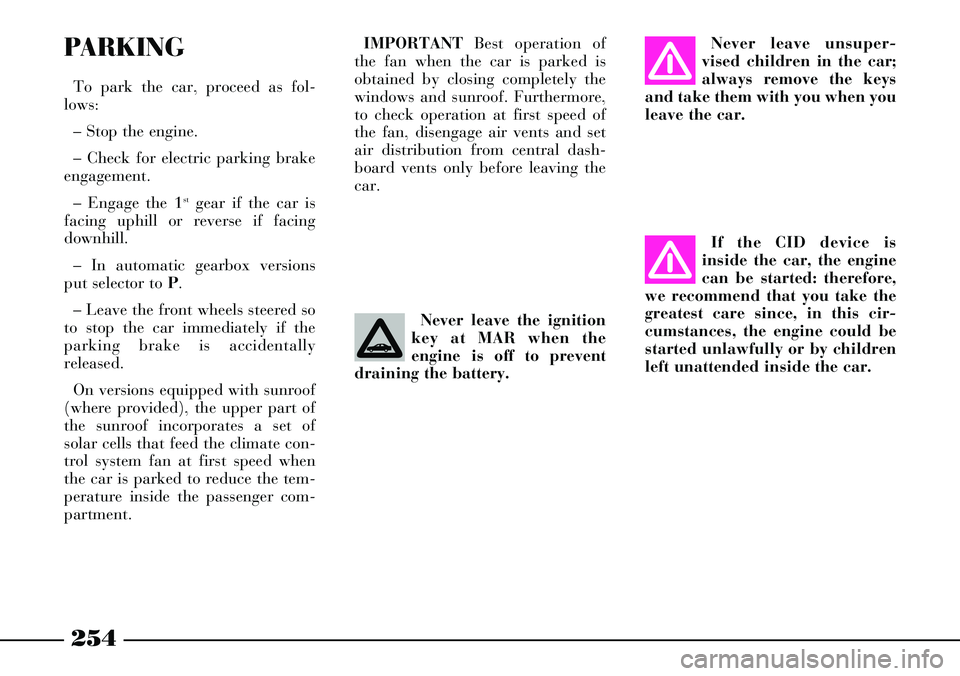
254
Never leave unsuper-
vised children in the car;
always remove the keys
and take them with you when you
leave the car.
If the CID device is
inside the car, the engine
can be started: therefore,
we recommend that you take the
greatest care since, in this cir-
cumstances, the engine could be
started unlawfully or by children
left unattended inside the car.PARKING
To park the car, proceed as fol-
lows:
– Stop the engine.
– Check for electric parking brake
engagement.
– Engage the 1
stgear if the car is
facing uphill or reverse if facing
downhill.
– In automatic gearbox versions
put selector to P.
– Leave the front wheels steered so
to stop the car immediately if the
parking brake is accidentally
released.
On versions equipped with sunroof
(where provided), the upper part of
the sunroof incorporates a set of
solar cells that feed the climate con-
trol system fan at first speed when
the car is parked to reduce the tem-
perature inside the passenger com-
partment.Never leave the ignition
key at MAR when the
engine is off to prevent
draining the battery.
IMPORTANT Best operation of
the fan when the car is parked is
obtained by closing completely the
windows and sunroof. Furthermore,
to check operation at first speed of
the fan, disengage air vents and set
air distribution from central dash-
board vents only before leaving the
car.
Page 256 of 386
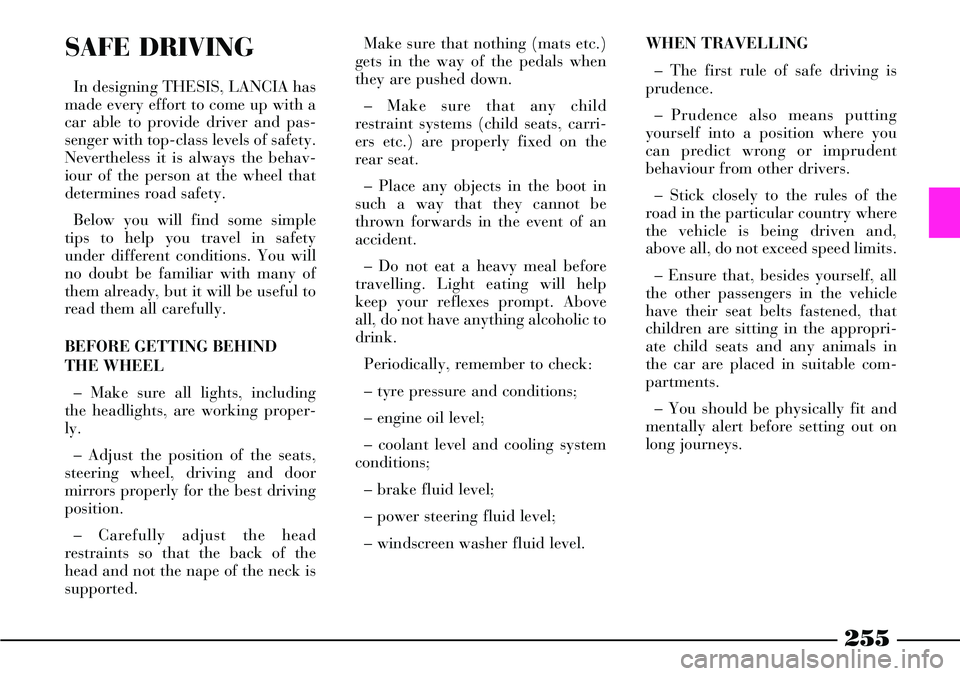
255
SAFE DRIVING
In designing THESIS, LANCIA has
made every effort to come up with a
car able to provide driver and pas-
senger with top-class levels of safety.
Nevertheless it is always the behav-
iour of the person at the wheel that
determines road safety.
Below you will find some simple
tips to help you travel in safety
under different conditions. You will
no doubt be familiar with many of
them already, but it will be useful to
read them all carefully.
BEFORE GETTING BEHIND
THE WHEEL
– Make sure all lights, including
the headlights, are working proper-
ly.
– Adjust the position of the seats,
steering wheel, driving and door
mirrors properly for the best driving
position.
– Carefully adjust the head
restraints so that the back of the
head and not the nape of the neck is
supported. Make sure that nothing (mats etc.)
gets in the way of the pedals when
they are pushed down.
– Make sure that any child
restraint systems (child seats, carri-
ers etc.) are properly fixed on the
rear seat.
– Place any objects in the boot in
such a way that they cannot be
thrown forwards in the event of an
accident.
– Do not eat a heavy meal before
travelling. Light eating will help
keep your reflexes prompt. Above
all, do not have anything alcoholic to
drink.
Periodically, remember to check:
– tyre pressure and conditions;
– engine oil level;
– coolant level and cooling system
conditions;
– brake fluid level;
– power steering fluid level;
– windscreen washer fluid level. WHEN TRAVELLING
– The first rule of safe driving is
prudence.
– Prudence also means putting
yourself into a position where you
can predict wrong or imprudent
behaviour from other drivers.
– Stick closely to the rules of the
road in the particular country where
the vehicle is being driven and,
above all, do not exceed speed limits.
– Ensure that, besides yourself, all
the other passengers in the vehicle
have their seat belts fastened, that
children are sitting in the appropri-
ate child seats and any animals in
the car are placed in suitable com-
partments.
– You should be physically fit and
mentally alert before setting out on
long journeys.
Page 257 of 386

256
Make sure that any mats
are appropriate in size:
any hindrance, even
slight, to the braking system may
require a higher pedal stroke
than normal.
Water, ice and salt on
the road may deposit on
brake disks, reducing
braking efficiency the first time
they are used.Driving while drunk or
under the influence of
drugs or certain medi-
cines is dangerous both for you
and other road users.
Always fasten both front
and back seat belts,
including child restraint
systems if there are children trav-
elling with you. Travelling with
seat belts unfastened increases
the risk of injury or death if you
are involved in a collision. Take care when fitting
additional spoilers, alloy
rims and wheel caps: they
might reduce ventilation of the
brakes, thus their efficiency dur-
ing abrupt braking or long down-
hill slopes.
Never drive with objects
on the floor in front of the
driver’s seat: they might
get stuck under the pedals mak-
ing it impossible to accelerate or
brake.
Page 258 of 386
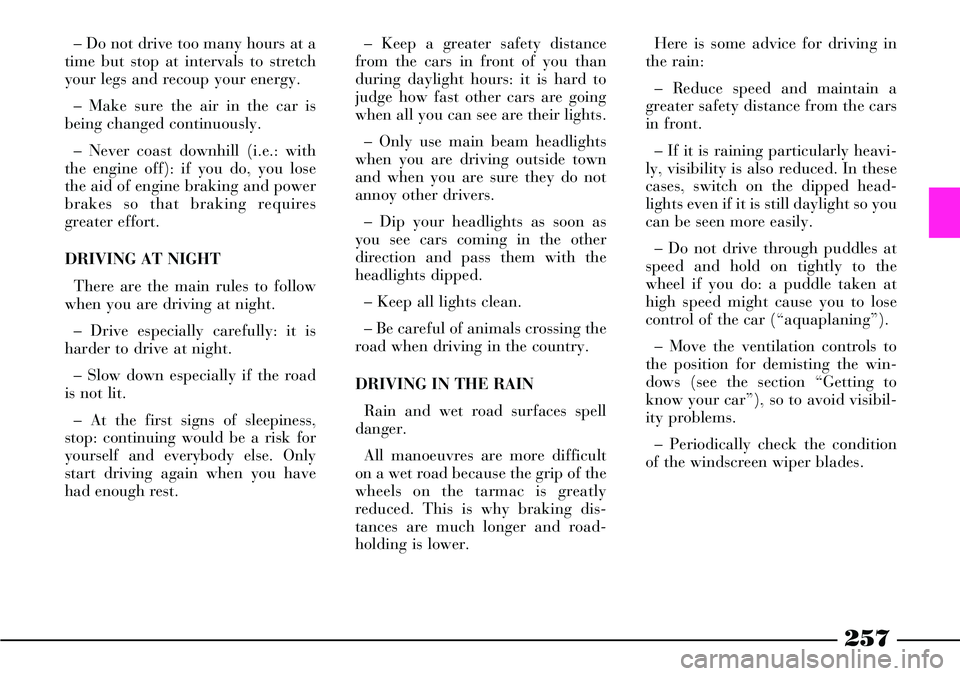
257
– Keep a greater safety distance
from the cars in front of you than
during daylight hours: it is hard to
judge how fast other cars are going
when all you can see are their lights.
– Only use main beam headlights
when you are driving outside town
and when you are sure they do not
annoy other drivers.
– Dip your headlights as soon as
you see cars coming in the other
direction and pass them with the
headlights dipped.
– Keep all lights clean.
– Be careful of animals crossing the
road when driving in the country.
DRIVING IN THE RAIN
Rain and wet road surfaces spell
danger.
All manoeuvres are more difficult
on a wet road because the grip of the
wheels on the tarmac is greatly
reduced. This is why braking dis-
tances are much longer and road-
holding is lower.Here is some advice for driving in
the rain:
– Reduce speed and maintain a
greater safety distance from the cars
in front.
– If it is raining particularly heavi-
ly, visibility is also reduced. In these
cases, switch on the dipped head-
lights even if it is still daylight so you
can be seen more easily.
– Do not drive through puddles at
speed and hold on tightly to the
wheel if you do: a puddle taken at
high speed might cause you to lose
control of the car (“aquaplaning”).
– Move the ventilation controls to
the position for demisting the win-
dows (see the section “Getting to
know your car”), so to avoid visibil-
ity problems.
– Periodically check the condition
of the windscreen wiper blades. – Do not drive too many hours at a
time but stop at intervals to stretch
your legs and recoup your energy.
– Make sure the air in the car is
being changed continuously.
– Never coast downhill (i.e.: with
the engine off): if you do, you lose
the aid of engine braking and power
brakes so that braking requires
greater effort.
DRIVING AT NIGHT
There are the main rules to follow
when you are driving at night.
– Drive especially carefully: it is
harder to drive at night.
– Slow down especially if the road
is not lit.
– At the first signs of sleepiness,
stop: continuing would be a risk for
yourself and everybody else. Only
start driving again when you have
had enough rest.
Page 259 of 386
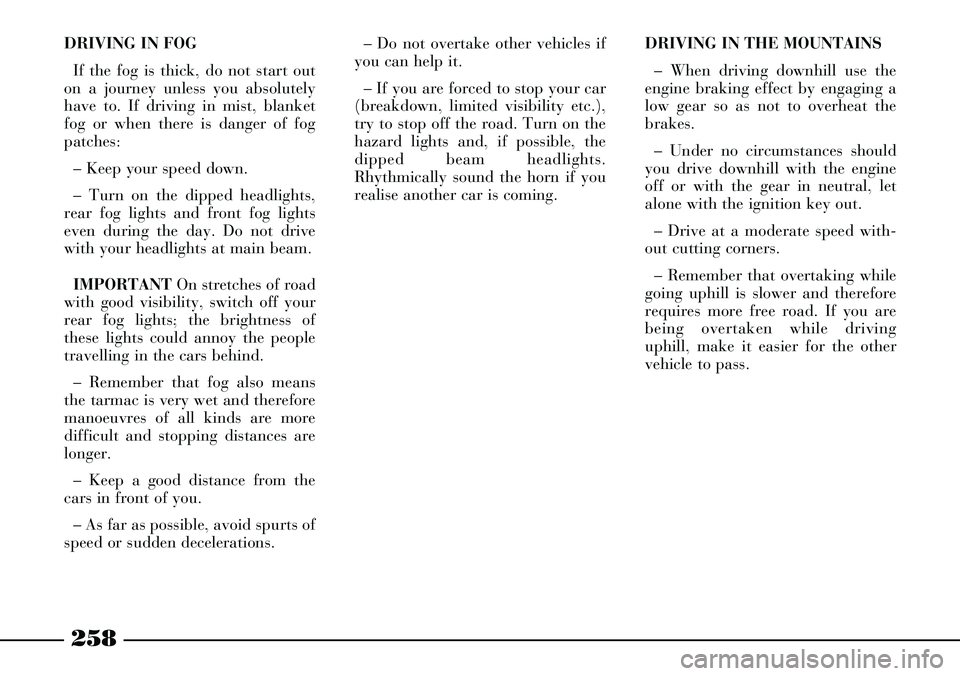
258
DRIVING IN FOG
If the fog is thick, do not start out
on a journey unless you absolutely
have to. If driving in mist, blanket
fog or when there is danger of fog
patches:
– Keep your speed down.
– Turn on the dipped headlights,
rear fog lights and front fog lights
even during the day. Do not drive
with your headlights at main beam.
IMPORTANTOn stretches of road
with good visibility, switch off your
rear fog lights; the brightness of
these lights could annoy the people
travelling in the cars behind.
– Remember that fog also means
the tarmac is very wet and therefore
manoeuvres of all kinds are more
difficult and stopping distances are
longer.
– Keep a good distance from the
cars in front of you.
– As far as possible, avoid spurts of
speed or sudden decelerations. – Do not overtake other vehicles if
you can help it.
– If you are forced to stop your car
(breakdown, limited visibility etc.),
try to stop off the road. Turn on the
hazard lights and, if possible, the
dipped beam headlights.
Rhythmically sound the horn if you
realise another car is coming. DRIVING IN THE MOUNTAINS
– When driving downhill use the
engine braking effect by engaging a
low gear so as not to overheat the
brakes.
– Under no circumstances should
you drive downhill with the engine
off or with the gear in neutral, let
alone with the ignition key out.
– Drive at a moderate speed with-
out cutting corners.
– Remember that overtaking while
going uphill is slower and therefore
requires more free road. If you are
being overtaken while driving
uphill, make it easier for the other
vehicle to pass.
Page 260 of 386
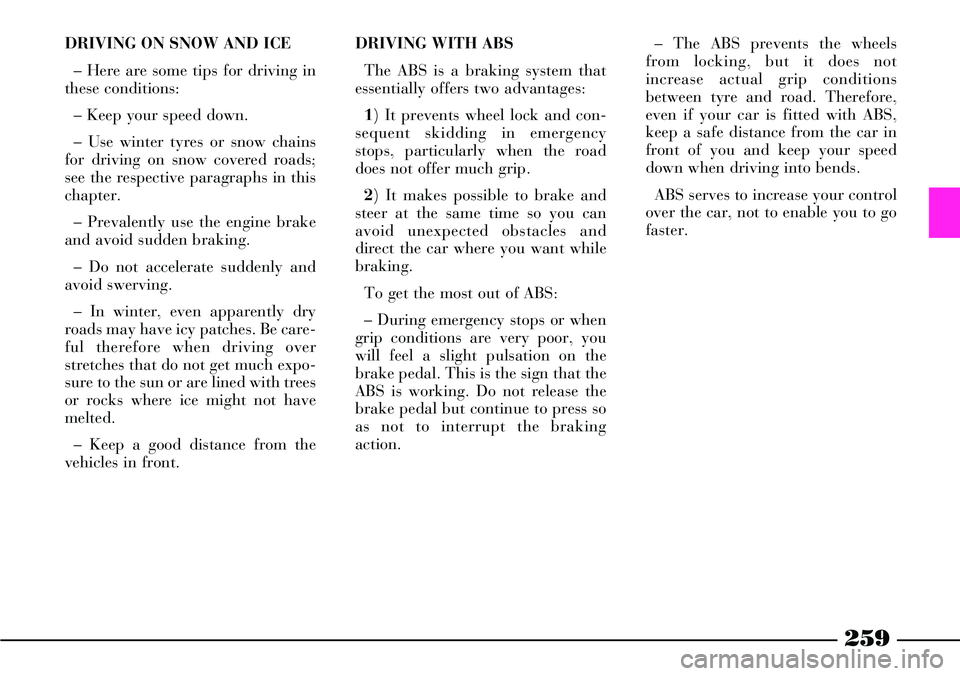
259
DRIVING ON SNOW AND ICE
– Here are some tips for driving in
these conditions:
– Keep your speed down.
– Use winter tyres or snow chains
for driving on snow covered roads;
see the respective paragraphs in this
chapter.
– Prevalently use the engine brake
and avoid sudden braking.
– Do not accelerate suddenly and
avoid swerving.
– In winter, even apparently dry
roads may have icy patches. Be care-
ful therefore when driving over
stretches that do not get much expo-
sure to the sun or are lined with trees
or rocks where ice might not have
melted.
– Keep a good distance from the
vehicles in front.DRIVING WITH ABS
The ABS is a braking system that
essentially offers two advantages:
1) It prevents wheel lock and con-
sequent skidding in emergency
stops, particularly when the road
does not offer much grip.
2) It makes possible to brake and
steer at the same time so you can
avoid unexpected obstacles and
direct the car where you want while
braking.
To get the most out of ABS:
– During emergency stops or when
grip conditions are very poor, you
will feel a slight pulsation on the
brake pedal. This is the sign that the
ABS is working. Do not release the
brake pedal but continue to press so
as not to interrupt the braking
action.– The ABS prevents the wheels
from locking, but it does not
increase actual grip conditions
between tyre and road. Therefore,
even if your car is fitted with ABS,
keep a safe distance from the car in
front of you and keep your speed
down when driving into bends.
ABS serves to increase your control
over the car, not to enable you to go
faster.